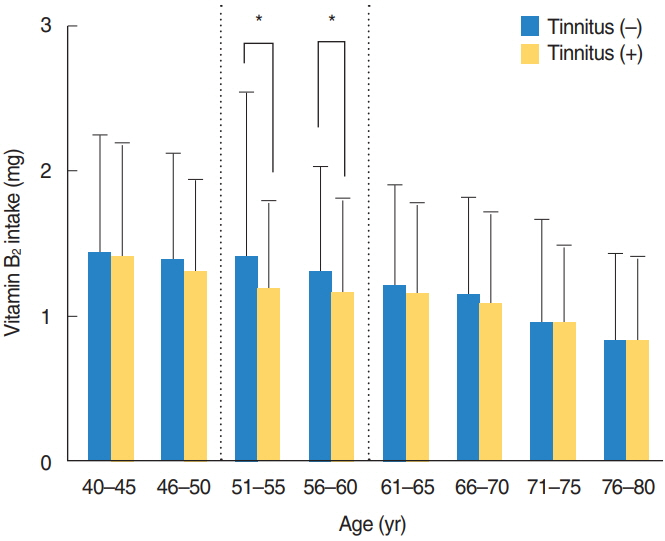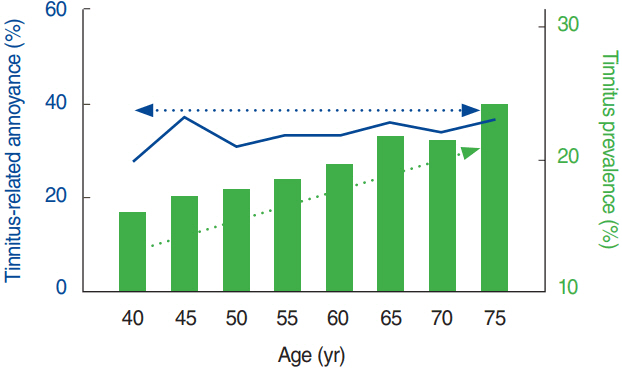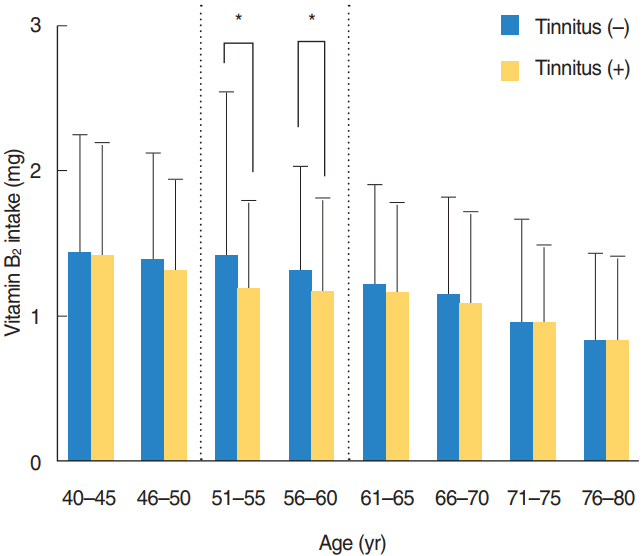Clin Exp Otorhinolaryngol.
2018 Sep;11(3):158-165. 10.21053/ceo.2017.01221.
Relationship Between Diet and Tinnitus: Korea National Health and Nutrition Examination Survey
- Affiliations
-
- 1Department of Otorhinolaryngology-Head and Neck Surgery, SMG-SNU Boramae Medical Center, Seoul National University College of Medicine, Seoul, Korea. yhkiment@gmail.com
- KMID: 2429004
- DOI: http://doi.org/10.21053/ceo.2017.01221
Abstract
OBJECTIVES
This study aimed to analyze the association between nutritional intake and tinnitus prevalence by evaluating a large cross-sectional cohort.
METHODS
Data from the Korea National Health and Nutrition Examination Survey collected between 2013 and 2015 were analyzed. The study population consisted of 7,621 individuals aged 40 to 80 years with complete tinnitus-related data. Individuals with inadequate responses to tinnitus history, noise exposure in the work place, or subjective hearing loss were excluded. Prevalence of tinnitus and tinnitus-related annoyance, and nutrition intake were measured using this questionnaire, and associations between tinnitus and nutritional data were evaluated by binary logistic regression analysis.
RESULTS
Subjective tinnitus was reported by 1,435 individuals with subjective normal hearing (18.8%). Prevalence of tinnitus increased with age. However, among individuals with tinnitus, the proportion of individuals with tinnitus-related annoyance was similar across age groups. Older age, female sex, lower body mass index (BMI), and less vitamin B2 intake were significantly associated with tinnitus (P < 0.001, P=0.002, P=0.041, P=0.013, respectively). Vitamin B2 intake was significantly less in individuals with tinnitus who were middle-aged (ages 51-55 and 56-60 years, P=0.012 and P=0.020, respectively). Less intake of water, protein, and vitamin B3 were associated with tinnitus-related annoyance (P=0.038, P=0.009, and P=0.005, respectively). Prevalence of annoyance was significantly associated with less water intake in younger ages (age 45-55 years) but with less protein and vitamin B3 intake in older ages (age 66-80 years).
CONCLUSION
Reduced intake of vitamin B2 and B3, water, and protein may be associated with tinnitus and tinnitus-related annoyance, and further studies regarding the importance of adequate nutritional intake in the tinnitus management need to be performed.
Keyword
MeSH Terms
Figure
Reference
-
1. Moller AR. Tinnitus: presence and future. Prog Brain Res. 2007; 166:3–16.2. Nondahl DM, Cruickshanks KJ, Huang GH, Klein BE, Klein R, Tweed TS, et al. Generational differences in the reporting of tinnitus. Ear Hear. 2012; Sep-Oct. 33(5):640–4.
Article3. Allman BL, Baizer JS, Salvi RJ, Lobarinas E. Special issue in hearing research: neuroscience of tinnitus. Hear Res. 2013; Jan. 295:1–2.
Article4. Kim YH, Jung HJ, Kang SI, Park KT, Choi JS, Oh SH, et al. Tinnitus in children: association with stress and trait anxiety. Laryngoscope. 2012; Oct. 122(10):2279–84.
Article5. Joo YH, Han KD, Park KH. Association of hearing loss and tinnitus with health-related quality of life: the Korea National Health and Nutrition Examination Survey. PLoS One. 2015; Jun. 10(6):e0131247.
Article6. Friberg E, Jansson C, Mittendorfer-Rutz E, Rosenhall U, Alexanderson K. Sickness absence due to otoaudiological diagnoses and risk of disability pension: a nationwide Swedish prospective cohort study. PLoS One. 2012; Jan. 7(1):e29966.
Article7. Yang S, Weiner BD, Zhang LS, Cho SJ, Bao S. Homeostatic plasticity drives tinnitus perception in an animal model. Proc Natl Acad Sci U S A. 2011; Sep. 108(36):14974–9.
Article8. Zenner HP, Delb W, Kroner-Herwig B, Jager B, Peroz I, Hesse G, et al. A multidisciplinary systematic review of the treatment for chronic idiopathic tinnitus. Eur Arch Otorhinolaryngol. 2017; May. 274(5):2079–91.
Article9. McCormack A, Edmondson-Jones M, Mellor D, Dawes P, Munro KJ, Moore DR, et al. Association of dietary factors with presence and severity of tinnitus in a middle-aged UK population. PLoS One. 2014; Dec. 9(12):e114711.
Article10. Spankovich C, Bishop C, Johnson MF, Elkins A, Su D, Lobarinas E, et al. Relationship between dietary quality, tinnitus and hearing level: data from the national health and nutrition examination survey, 1999-2002. Int J Audiol. 2017; Oct. 56(10):716–22.
Article11. Asher BF, Seidman M, Snyderman C. Complementary and alternative medicine in otolaryngology. Laryngoscope. 2001; Aug. 111(8):1383–9.
Article12. Coelho C, Witt SA, Ji H, Hansen MR, Gantz B, Tyler R. Zinc to treat tinnitus in the elderly: a randomized placebo controlled crossover trial. Otol Neurotol. 2013; Aug. 34(6):1146–54.13. Shargorodsky J, Curhan GC, Farwell WR. Prevalence and characteristics of tinnitus among US adults. Am J Med. 2010; Aug. 123(8):711–8.
Article14. Park B, Choi HG, Lee HJ, An SY, Kim SW, Lee JS, et al. Analysis of the prevalence of and risk factors for tinnitus in a young population. Otol Neurotol. 2014; Aug. 35(7):1218–22.
Article15. Eggermont JJ, Roberts LE. The neuroscience of tinnitus. Trends Neurosci. 2004; Nov. 27(11):676–82.
Article16. Weisz N, Moratti S, Meinzer M, Dohrmann K, Elbert T. Tinnitus perception and distress is related to abnormal spontaneous brain activity as measured by magnetoencephalography. PLoS Med. 2005; Jun. 2(6):e153.
Article17. Llinas RR, Ribary U, Jeanmonod D, Kronberg E, Mitra PP. Thalamocortical dysrhythmia: a neurological and neuropsychiatric syndrome characterized by magnetoencephalography. Proc Natl Acad Sci U S A. 1999; Dec. 96(26):15222–7.
Article18. Coelho C, Tyler R, Ji H, Rojas-Roncancio E, Witt S, Tao P, et al. Survey on the effectiveness of dietary supplements to treat tinnitus. Am J Audiol. 2016; Sep. 25(3):184–205.
Article19. Maizels M, Blumenfeld A, Burchette R. A combination of riboflavin, magnesium, and feverfew for migraine prophylaxis: a randomized trial. Headache. 2004; Oct. 44(9):885–90.
Article20. Namazi N, Heshmati J, Tarighat-Esfanjani A. Supplementation with riboflavin (vitamin B2) for migraine prophylaxis in adults and children: a review. Int J Vitam Nutr Res. 2015; Jan. 85(1-2):79–87.
Article21. Neri S, Signorelli S, Pulvirenti D, Mauceri B, Cilio D, Bordonaro F, et al. Oxidative stress, nitric oxide, endothelial dysfunction and tinnitus. Free Radic Res. 2006; Jun. 40(6):615–8.
Article22. Kumawat M, Sharma TK, Singh I, Singh N, Singh SK, Ghalaut VS, et al. Decrease in antioxidant status of plasma and erythrocytes from geriatric population. Dis Markers. 2012; 33(6):303–8.
Article23. Seidman MD, Ahsan SF. Current opinion: the management of tinnitus. Curr Opin Otolaryngol Head Neck Surg. 2015; Oct. 23(5):376–81.24. Meyer B. A multicenter study of tinnitus: epidemiology and therapy. Ann Otolaryngol Chir Cervicofac. 1986; 103(3):185–8.25. McAuley E, McNulty H, Hughes C, Strain JJ, Ward M. Riboflavin status, MTHFR genotype and blood pressure: current evidence and implications for personalized nutrition. Proc Nutr Soc. 2016; Aug. 75(3):405–14.26. Shakersain B, Santoni G, Faxen-Irving G, Rizzuto D, Fratiglioni L, Xu W. Nutritional status and survival among old adults: an 11-year population-based longitudinal study. Eur J Clin Nutr. 2016; Mar. 70(3):320–5.
Article27. Hulshof JH, Vermeij P. The effect of nicotinamide on tinnitus: a double-blind controlled study. Clin Otolaryngol Allied Sci. 1987; Jun. 12(3):211–4.
Article28. Flottorp G, Wille C. Nicotinic acid treatment of tinnitus: a clinical, audiological examination. Acta Otolaryngol Suppl. 1954; 118:85–99.29. Hameed MK, Sheikh ZA, Ahmed A, Najam A. Atorvastatin in the management of tinnitus with hyperlipidemias. J Coll Physicians Surg Pak. 2014; Dec. 24(12):927–30.30. Rubin W. Nutrition, biochemistry, and tinnitus. Int Tinnitus J. 1999; Feb. 5(2):144–5.
- Full Text Links
- Actions
-
Cited
- CITED
-
- Close
- Share
- Similar articles
-
- Is Hypozincemia Related to Tinnitus?: A Population Study Using Data From the Korea National Health and Nutrition Examination Survey
- The Current Status and the Perspectives of Nutrition Survey
- Tinnitus Assessment
- Psychiatric Distress as a Common Risk Factor for Tinnitus and Joint Pain: A National Population-Based Survey
- Association of Household Food Security with Dietary Intake: Based on the Third (2005) Korea National Health and Nutrition Examination Survey (KNHANES III)





